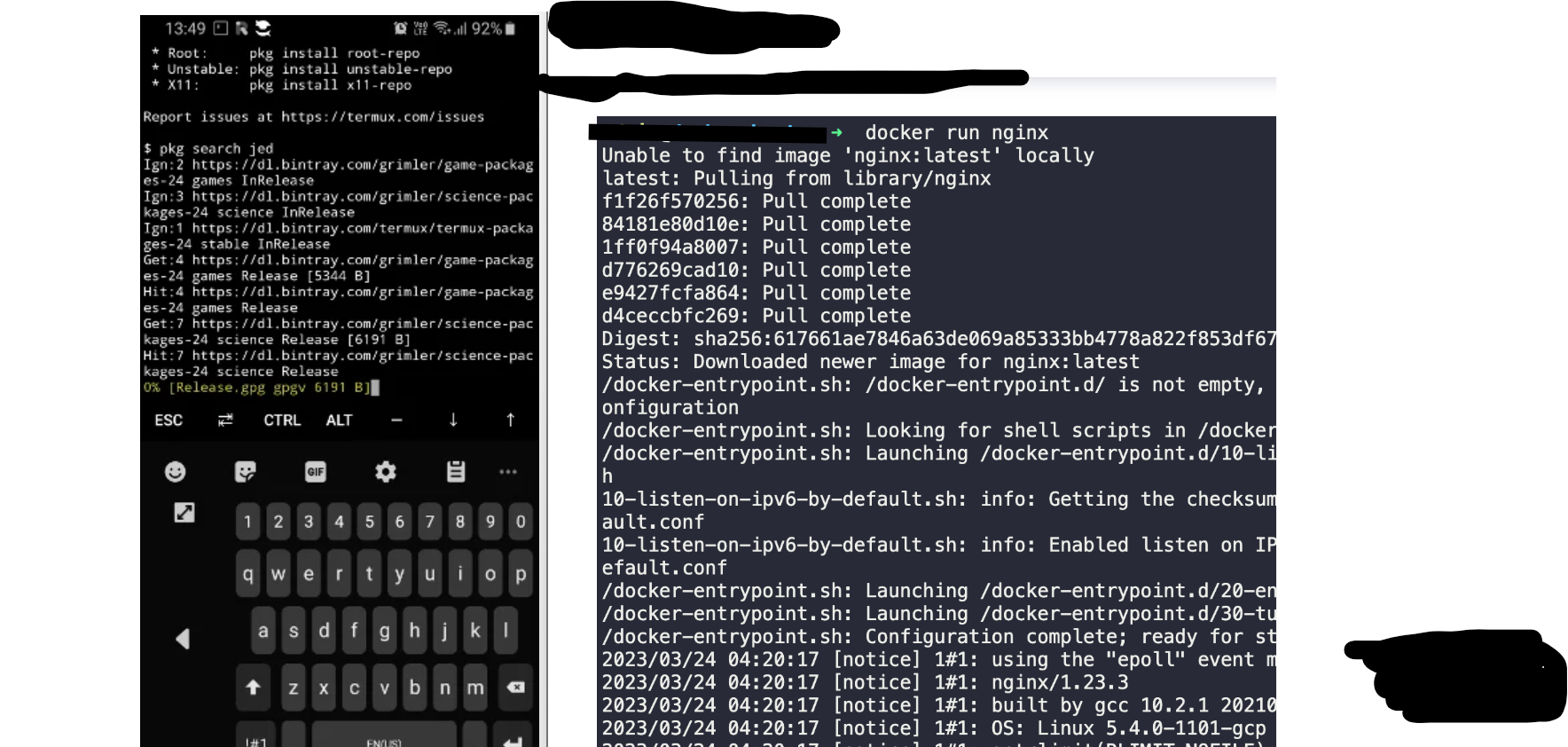How I went from coding on my phone to deploying containerized applications - and why you shouldn't give up if you're starting with limited resources
The Beginning: When a Phone Was My Only Option
When I first transitioned into tech, I didn't have access to a laptop. The only way I could make anything happen in technology was to start using my phone to code. It sounds impossible, right? But sometimes, limitations force us to be more creative than we ever thought possible.
I'm not going to lie - it was tough initially. I didn't know what apps to use, what wouldn't work, or how to navigate the restrictions that come with mobile development. But I was determined to make it work because giving up wasn't an option.
Enter Termux: My Mobile Development Lifeline
That's when I discovered Termux - a fantastic terminal emulator application that became my gateway to serious mobile development. While it had its limitations and restrictions, it opened up possibilities I never imagined.
With Termux, I could:
Run a Linux environment on my Android device
Install development tools and packages
Write and test code directly on my phone
Learn containerization concepts hands-on
The Docker Journey Begins
Learning Docker on a phone might sound crazy, but it's exactly what I did. Here's how I made it work:
Setting Up the Environment
# First, I updated Termux packages
pkg update && pkg upgrade
# Installed essential tools
pkg install git
pkg install nodejs
pkg install python
# While I couldn't run Docker directly on Termux,
# I could learn the concepts and write Dockerfiles
Building My First Application
I started with a simple Node.js application - something I could actually test and understand:
// app.js - My first containerized app
const express = require('express');
const app = express();
const port = 3000;
app.get('/', (req, res) => {
res.send('Hello from my phone-built Docker container!');
});
app.listen(port, () => {
console.log(`App running on port ${port}`);
});
Creating the Dockerfile
Even though I couldn't run Docker on my phone, I could learn the syntax and understand the concepts:
# Dockerfile - written and tested on my phone
FROM node:16-alpine
WORKDIR /app
COPY package*.json ./
RUN npm install
COPY . .
EXPOSE 3000
CMD ["node", "app.js"]
The Limitations Were Real
Let me be honest about the challenges:
Screen size: Writing code on a small screen was eye-straining
Performance: Limited processing power meant slower compilation
Testing: I couldn't fully test Docker containers on the phone
Debugging: Limited debugging tools made troubleshooting harder
Multi-tasking: Switching between apps and documentation was cumbersome
The Breakthrough Moment
When I finally got access to a laptop, everything clicked into place. All those hours of learning Docker concepts, writing Dockerfiles, and understanding containerization principles on my phone suddenly made sense.
# The moment of truth - my first successful Docker build
docker build -t my-phone-app .
docker run -p 3000:3000 my-phone-app
Seeing that container run successfully felt like magic. All the struggle, all the squinting at my phone screen, all the workarounds - it was all worth it.
What I Learned Along the Way
1. Limitations Breed Innovation
Being forced to work within constraints made me more resourceful. I learned to:
Break down complex problems into smaller, manageable pieces
Focus on understanding concepts rather than just following tutorials
Find creative solutions to technical challenges
2. The Fundamentals Matter Most
Without fancy IDEs or multiple monitors, I had to truly understand:
How containerization works at a fundamental level
The purpose and structure of Dockerfiles
Container orchestration concepts
Deployment strategies and best practices
3. Persistence Pays Off
There were countless moments when I wanted to give up. The tiny screen, the limited tools, the constant switching between apps - it all felt overwhelming. But each small victory built momentum.
Practical Tips for Phone-Based Development
If you're in a similar situation, here are strategies that worked for me:
Essential Apps
Termux: Your primary development environment
QuickEdit: For writing and editing code files
Markor: For documentation and note-taking
Chrome: For testing and research
Workflow Optimization
# Create aliases for common commands
alias ll='ls -la'
alias gs='git status'
alias gp='git push'
# Use tmux for session management
pkg install tmux
tmux new -s dev
Learning Strategy
Focus on concepts first: Understand what Docker does before worrying about running it
Write code daily: Even 30 minutes of coding on your phone builds muscle memory
Document everything: Keep notes on what works and what doesn't
Join communities: Connect with other developers online for support
The Deployment Success
When I finally deployed my first containerized application, it wasn't just a technical achievement - it was validation that resourcefulness and determination can overcome any limitation.
# The commands that changed everything
docker build -t my-first-app .
docker run -d -p 80:3000 my-first-app
docker ps
To Anyone Facing Similar Challenges
If you're reading this and thinking, "I can't learn DevOps because I don't have a laptop," or "I can't afford the tools everyone else has," let me tell you something:
Your limitations are not your limitations - they're your training grounds.
The skills I developed learning Docker on my phone - problem-solving, resourcefulness, deep understanding of fundamentals - these became my superpowers when I finally had access to proper tools.
What's Next?
Now that you know it's possible, here's how to start:
Download Termux and get comfortable with the terminal
Start small - build simple applications first
Learn the concepts - understand what containers solve
Practice daily - even 15 minutes makes a difference
Connect with others - join developer communities for support
Final Thoughts
The journey from phone coding to production deployments taught me that success in tech isn't about having the perfect setup - it's about having the determination to start with what you have.
Every expert was once a beginner. Every professional developer once struggled with basic concepts. The difference is that they didn't let their circumstances define their possibilities.
Your phone might be your only tool today, but it's also your gateway to tomorrow's opportunities. Start where you are, use what you have, and do what you can.
The container you build today - whether on a phone or a laptop - is just the beginning of your DevOps journey.
What challenges are you facing in your tech journey? Drop a comment below and let's solve them together. Remember: if I can learn Docker on a phone, you can overcome whatever obstacles you're facing.
Tags: #Docker #Mobile Development #Termux #DevOps #Beginner #Containerization #Linux #Self-taught #Tech Journey



